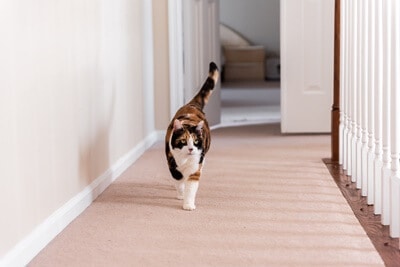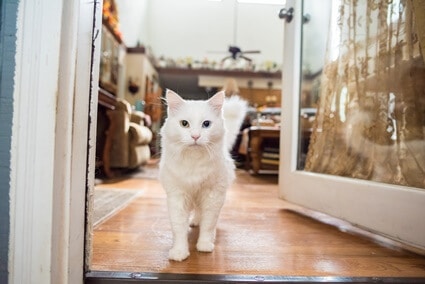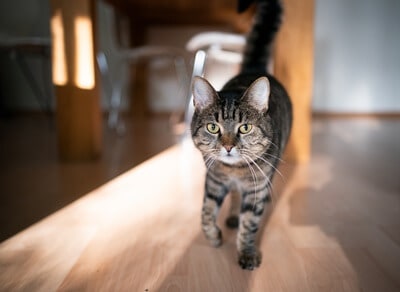Space requirements for cats aren’t what you’d expect. It’s natural to assume that your cat would want as much room as possible, but cats are less concerned about space and more interested in the layout of your home.
The average domestic cat needs a minimum of 18 square feet of living space. Even the smallest of homes provide rooms with this much space. If you have two cats, you’ll need twice this amount of space.
An optimal home layout is more important than the property’s size as cats like climbing and hiding. If your cat doesn’t have places to retreat, it’ll become stressed. Equally, a wide-open space can make cats feel vulnerable.
How Many Square Feet of Space Does a Cat Need?
Space requirements depend on your cat’s breed, size, weight, health, and age. Some felines will be more energetic and playful than others, so a very active cat will need more room to run around, jump, and play.
The ASPCA recommends allowing 18 square feet of space per cat. So, if you need to house multiple cats, you’ll need to provide extra space.
The most important thing for a cat is ‘zoning.’ Even the largest home can make a cat feel uncomfortable, especially if it’s open plan with few hiding spots. Cats like to hide and have territory to call their own.
Do Cats Like Open Living Environments?
When people look for a home, the first thing that they’re drawn to is space. It may surprise you to learn that cats do not see things this way.
If a cat is faced with a substantial and unpopulated living area, it’ll feel uncomfortable. Felines like to remain hidden and not wander through open spaces as this makes them feel exposed and vulnerable.
According to Romper, cats prefer a small, enclosed area. This is why they find cardboard boxes so irresistible. Feline instincts tell them that they’re safer in an enclosed location that reminds them of the womb.
A small space is also warmer. The more open and wide a room, the longer it will take to heat up. Cats have desert-dwelling ancestors and have a higher body temperature than humans.
This doesn’t mean that cats will be uncomfortable in larger homes. It just means that their needs must be met, just like in smaller spaces. A larger room needs more hiding places and some higher ground.
Can a Cat Live in a Small Apartment?
Cats are happy to live in apartments. Cats tend to reserve their energy for short, controlled bursts. This is an instinctive behavior as cats live to hunt. By not wasting energy, they’ll have enough in reserve to stalk prey.
Also, cats find safety and contentment in more enclosed spaces. An apartment will provide lots of hiding places, such as cupboards and behind furniture.
If you live in an apartment, you should ensure that communal areas measure at least 18 square feet. However, if a cat previously roamed outdoors, being cooped up inside may lead to destructive behaviors.
If you want to keep multiple cats, you’ll need to think carefully about space. The ASPCA’s formula breaks down as follows:
- Measure the length of a room in feet
- Multiply the width of a room in feet
- Multiply these two numbers and divide the solution by 18
- This tells you how many cats can comfortably share a room
For example, if a room is 10×10 will be suitable for 5 cats. Of course, it depends on the layout of your home and the temperament of your cats.

Do I Need Spare Rooms for a Cat?
You don’t need a spare room, but it would be beneficial to have this space for your cat. Here’s why:
- Your cat can claim the room as its own. This will help manage its territorial instincts.
- You can keep the cat’s litter tray in this room.
- The cat can be fed in this room. Most cats like privacy while they eat. Just keep the food dish away from the drinking bowl.
- Your cat will have somewhere to escape to when feeling overwhelmed.
- The room can be turned into a cat gym, filled with toys and exercise equipment to keep it entertained.
Do I Need Outside Space for a Cat?
If your cat is used to living indoors, it’ll likely be content to remain there. In fact, PETA believes that all cats should be indoor cats. If you adopt a cat that’s used to the outdoors, a yard may be a good compromise.
Outside space also gives a cat the chance to exercise, and it’ll have space to run, jump, climb, and pursue prey. Of course, if your cat is feeling a bit lazy, it’ll just sunbathe. Few animals love the sun more than cats.
If you have multiple cats in a small home or apartment, an outdoor area is advisable. Any feline that feels under stress needs somewhere to escape. It also encourages more independence in timid cats.
What Are the Best Cats for Small Homes?
You can find breeds that thrive in limited space. If you take in an affectionate lap cat, it’ll want to be where you are located. If it’s curled up in your lap, it won’t notice the lack of surface area. Examples include:
- Birman
- Ragdoll
- Burmese
If you’re seeking a cat indifferent to small spaces, consider getting a:
- British Shorthair
- American Shorthair
These breeds are quiet, independent, non-shedding, and adaptable. So, they’ll feel more contented in an apartment or small house.

How Can I Tell if My Cat Needs More Space?
Cats are not always expressive animals, so you’ll need to learn their body language. Warning signs that a lack of space stresses your cat include:
- Spraying and urinating outside the litter box
- Always hiding under beds and other furniture
- Excessive grooming and scratching
- Destructive behavior, including scratching furniture
- Bolting for freedom whenever you open a door or window
How to Make a Small Space Cat-Friendly
If you don’t have a large home, improvise to make your cat comfortable. These steps will improve your cat’s quality of life:
- Keep the space clean. Cats do not enjoy unsanitary conditions.
- Avoid drafts in open areas. If you have an air conditioner or fan, don’t point it directly toward your cat’s preferred space.
- Play with your cat twice a day. It’ll enjoy the uninterrupted one-on-one time, and it will help it burn off energy.
- Nearby prey. Place a bird feeder outside the closed window or get a fish tank. Cats can entertain themselves for hours with these activities.
- Home setup. Arrange your furniture so that your cat has an obstacle course. This will make up for a lack of surface area.
- Hiding places. Cupboards can be good places for a cat to hide. Put cardboard boxes in various places for your cat to squeeze into.
Some cats thrive in smaller homes, especially ones that are nervous and skittish. In their minds, the more open space, the more opportunities predators have to attack them.
Take the time to understand your cat’s preferences and tailor its surroundings accordingly. The minimum space requirement will be met as long as a cat has 18 square feet of space.

